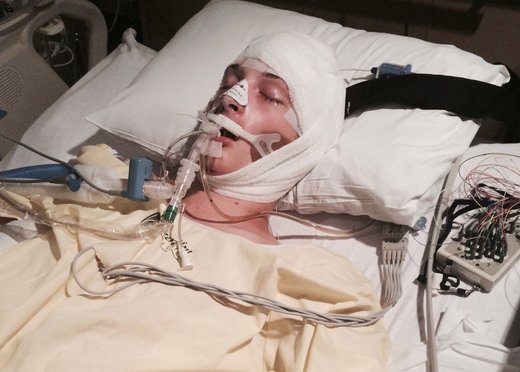
As the video opens we see a gray Pontiac enter the frame, and Bryce's dad, Matt, put his hand on his son's knee. His mom, Stacy, folded her arms, clutching a tissue. Tears began to form in both his parents' eyes, anticipating what everyone else in the room was about to see. Unfazed, Bryce leaned his 6-foot-1-inch frame forward, his eyes focused on the makeshift projector. He knew this piece of evidence absolved him of any wrongdoing.
In the video, Runnels pulls Bryce over and approaches the car. He tells Bryce to get out but doesn't give a reason. Bryce repeatedly asks if he is under arrest. Runnels says, "You're under arrest. Get your ass out of the car," and attempts to pull him out by force. He then tases Bryce for 23 seconds, handcuffs him, drags the boy's body behind the car, and deliberately drops him face first onto the asphalt road. Runnels may not have known it at the time, but Bryce was going into cardiac arrest. When the loud thud of the drop boomed throughout the courtroom, gasps echoed out. One woman looked down and covered her eyes with her hand. A man said, "Oh, my god." A police officer with the Kansas City Police Department quickly brought his fist to his mouth, turned to the man next to him, and whispered, "Jesus." Even those sitting behind the defendant — a few friends, his wife, his family — gasped, as if the recording revealed a truth about Runnels they had never considered.
Bryce Masters used his mobile phone to record his encounter with Officer Timothy Runnels on September 14, 2014.
Warning: This video contains graphic scenes of police violence.
Runnels faced a dire sentence that day — up to 10 years in federal prison. The catalyst for the crime was the 23-second Taser deployment straight into Bryce's chest. That's what caused him to go into cardiac arrest. Assistant U.S. Attorney David M. Ketchmark argued that the length of time that Runnels held down the Taser's trigger was an aggravating factor. One pull on the trigger sent electricity shooting out for five seconds; Runnels had held it down the equivalent of four pulls. Even so, the prosecution agreed that the initial Taser use was reasonable and within common police practice. Runnels's crime, depriving a minor of his civil rights, occurred when he dropped the dying 17-year-old boy on his face.
Matt Masters does not agree that the Taser use was reasonable, but he agrees it was common police practice. Matt is a 19-year veteran of the Kansas City Police Department with a slew of warrior-cop credentials. He has worked on SWAT teams and has been part of Kansas City's police narcotics unit, taking point on an estimated 1,000 search warrants during one three-year span. After Bryce was tased, Matt discovered something he'd never heard in any Taser training he'd gone through, something he resisted believing, because it violated an article of faith among police officers: Tasers can kill.
More specifically, Matt learned that on October 12, 2009, Taser International, the Scottsdale, Arizona-based maker of conducted electrical weapons, released a training bulletin suggesting that officers should avoid shooting suspects in the chest whenever possible. Five years later — on September 14, 2014 — it would be difficult to argue that Runnels was unable to avoid shooting Bryce in the chest. Yet the defense's argument for leniency was based on the claim that Runnels had acted reasonably as an officer right up until the moment he dropped Bryce on his face.
But the wounds Bryce suffered from that part of the assault have largely healed. The permanent injury he struggles with every day came as a result of the Taser. Bryce's brain was deprived of oxygen for six to eight minutes while he was in cardiac arrest. It was the Taser that almost killed Bryce.
Read the rest of the story here



Comment: Police recruiting standards practically select for candidates prone to this sort of brutal behaviour. Add the culture of impunity, and the endless supplies of military-grade toys, how could things not be otherwise?